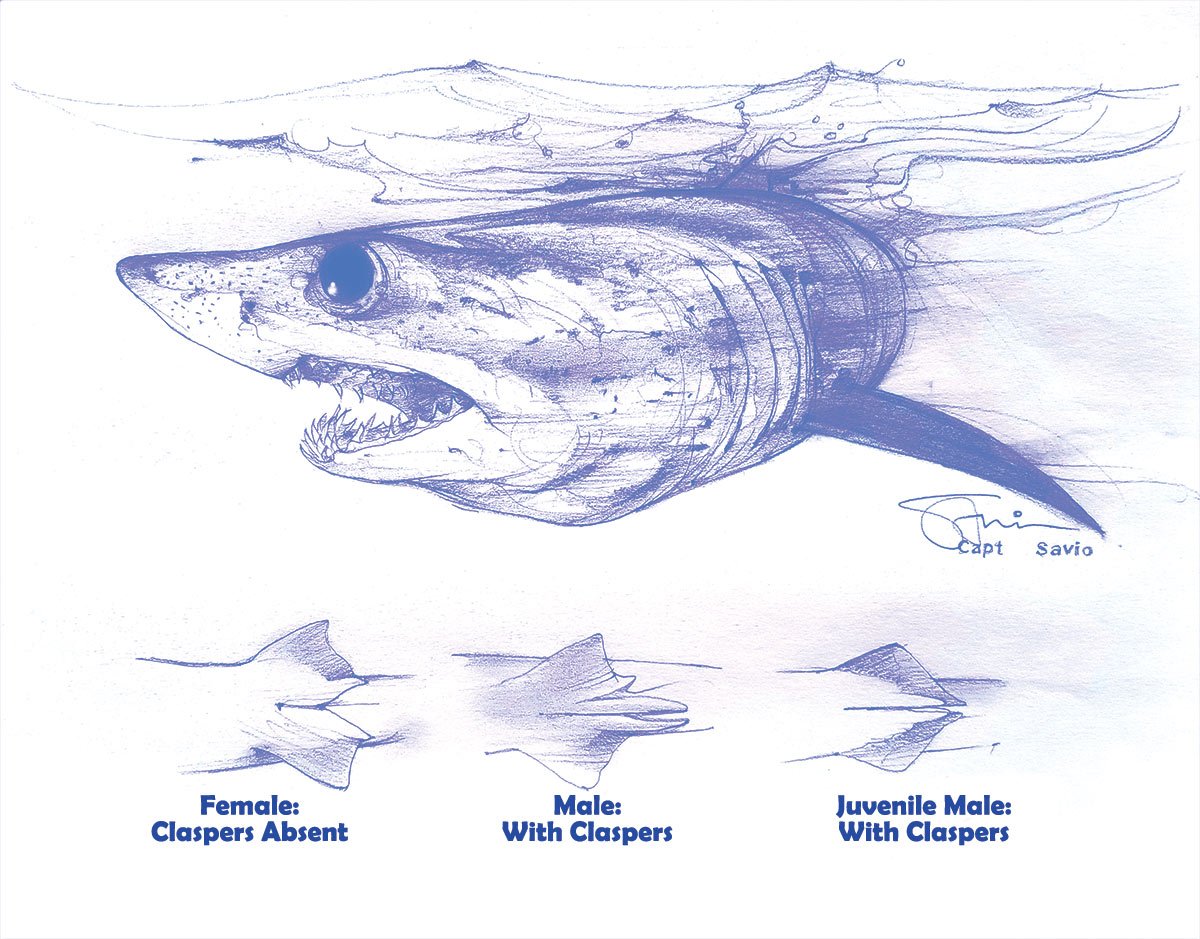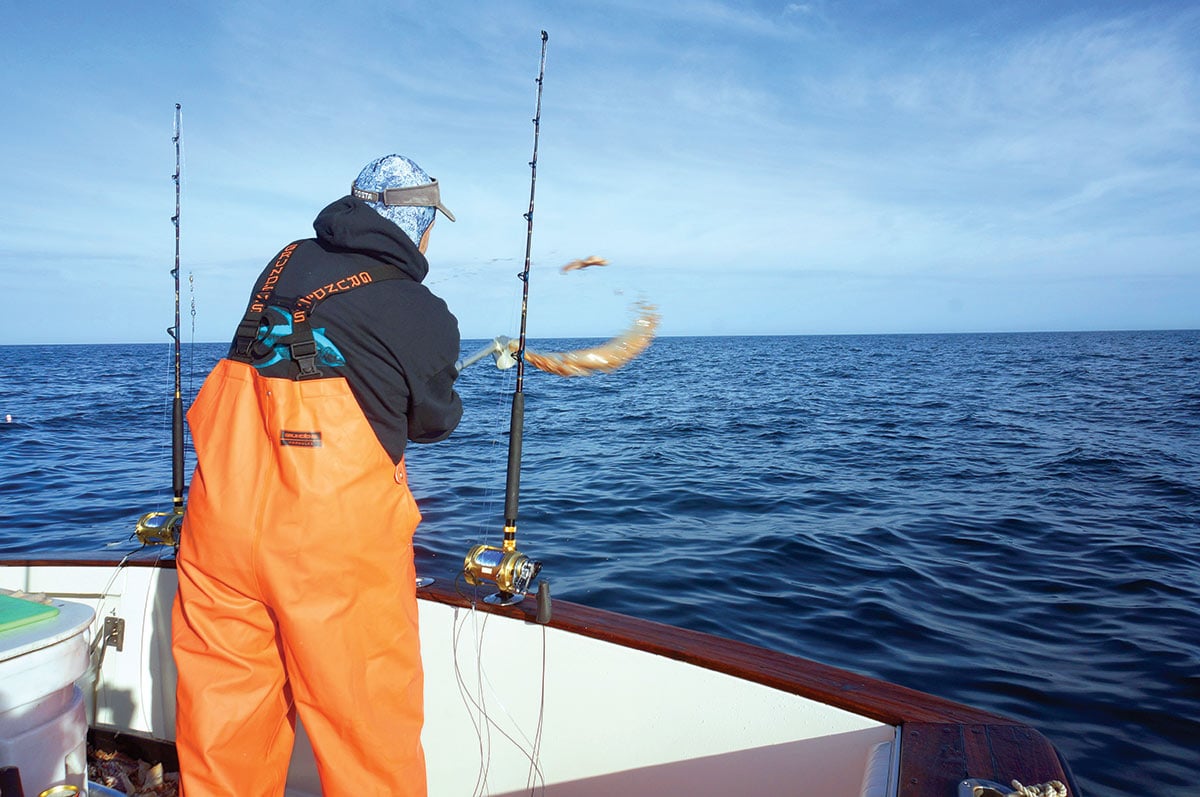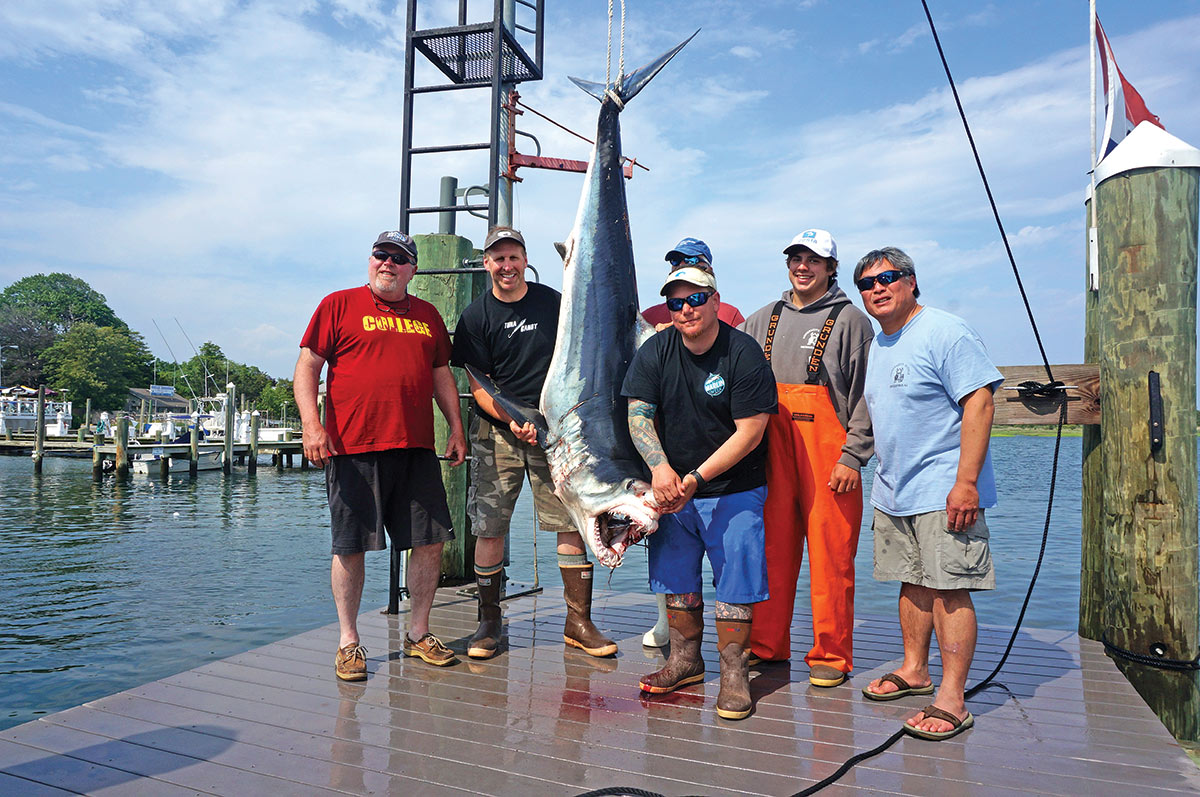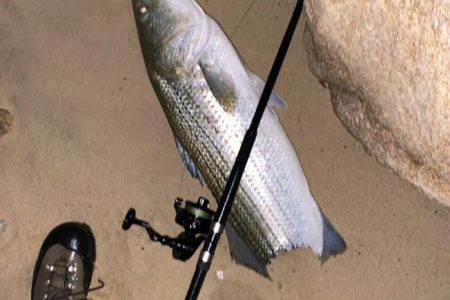
When it comes to bringing a few steaks home, size does matter!
Last year’s 2018 mako season was memorable for the unusually large, minimum size required to keep the fish. Now with the 2019 mako season about to kick off, there has been a collective sigh of relief as minimum size limits have been relaxed to a 71-inch minimum (fork length) on male shortfin makos, and 83-inch minimum on females.
Using a NOAA formula, a 71-inch mako is estimated at about 141 pounds, an 83-incher is estimated at about 229 pounds.
While hooking makos of any size is always a thrill, there has been increased emphasis on targeting the bigger makos that will exceed the minimum size limit and come back to the dock. This means boat captains and anglers have to tweak their strategies and tactics a bit to target these beasts.
Here are some of the strategies and tactics incorporated over the last three decades chasing the biggest makos.
Location, Location, Location
Finding monster makos starts with fishing areas most likely to hold big fish. Sure, big makos are caught every season on the inshore grounds inside the 20-fathom line (often chasing schools of bluefish), but tournament-winning crews put the throttles down and often run to and beyond the 30-fathom line and into the canyons.

Makos prefer water temperatures between 64 to 70 degrees, with 66 to 68 often being magical for the big boys and girls. Look for clean blue or blue-green water, preferably over “structure” such as wrecks, hard drop-offs or ridges (tight contour lines on bathymetric charts); topographical notches or trenches are prime real estate as well. Look for the presence of bait and bait slicks, birds picking, and other pelagics such as football-sized tuna or mackerel.
Whenever possible, figure out the course over ground drift as to slide up or down the slope, or into and out of deep-water holes. Night time is a particularly good time to target big makos, as so many predators like to prey at night. If a drift does not produce after a couple hours, consider making move to another likely area.
Go Big, or Go Home
Hooking and landing one of the toughest and most acrobatic pelagics means having the right gear. Lever-drag reels in the 30- to 50-pound class on matching 6-foot stand-up rods are a great start. Aboard Mushin Sportfishing, we spool our 50W’s with 100-pound braid for backing and top off with about 150 yards of 80- to 100-pound mono. We do not use wind-on leaders nor do we double the line. Crimp a sturdy 400-pound black ball-bearing swivel on the end.
Traditionally, most crews used shark-rigs consisting of an upper section of 8 feet of 480-pound stainless braided cable joined by a 400-pound black ball-bearing snap swivel to a lower section of 6 feet of #14 single-strand wire. In more recent years, many crews have substituted 6 feet of 500- to 600-pound mono for the single-strand wire with great success. Either way, crimp on a 20/0 to 24/0 non-offset circle hook.
When fishing large fillet baits (e.g., bluefish fillet), crimp on a “stinger” hook on a 14-inch length of 500-pound mono to the forward hook, putting a hook closer to the tail end of the bait. Colored skirts are often added forward of the first hook, but be sure to use a rubber band wrapped on the leader inside of the skirt to keep the skirt from sliding down and interfering with the hook set. The tail of the skirt should be just ahead of the eye of the leading hook. About half of our rigs have some sound rattles on the upper cable leader for sound attraction.
Other gear needed to ensure a successful landing include fighting belt/harness, two large flying gaffs with heavy rope, three straight gaffs with 5-inch hooks, two tail ropes, harpoon with 300-plus feet of line to A4 ball (not for tournaments), leadering gloves, and appropriate firearm/bangstick.
Drifting and Dreaming
Monster mako fishing can be 95% boredom with 5% absolute chaos! Most captains like to see a 1+ knot drift to cover some ground, disperse a healthy chum slick, and keep the baits fluttering. Set out two chum buckets – one on the bow and one on the stern – in chum bags or milk-crate assemblies. Pay attention to how much chum is getting dispersed or not – it should be steady and moderately heavy. Bring plenty of chum too; we carry 12 pails or more for most trips. While many use the traditional bunker or mackerel chums sold in 5-gallon pails, some sharpies have turned to bluefish chum. Supplement the steady flow of chum pails with hand-chopped pieces of bluefish, mackerel, or whatever other oily fish you can get your hands on.

Assign one crew member to cut and throw these small pieces of fish scraps in the slick – these tasty little morsels often pique that monster mako’s interest. These should be thrown at a rate where you see the last handful disappear before throwing the next. Jetting water streams on the surface is another way of calling in that big mako. After filleting a few bluefish for hook baits, we tie these bluefish racks on a 15-foot tether off the side of the boat.
We generally drift five rods, and have a sixth “pitch” rod at the ready. Our longest line is usually about 225 feet out and 80 feet down; we then stagger the subsequent baits in closer and higher up the water column, 175 out/60 down; 150 out/50 down; 100 out/45 down, and a “dangler” of 50 feet of line to hang the bait where it lays. The distances may need adjustment if there is a faster or slower drift – keep the baits to be where the chum is falling to.
We also use shark floats on all except the dangler and pitch rods, and use heavy rubber bands to wrap the mainline on the float. Be sure to use enough weight by banding a bank sinker on the mainline about 10’ above the leader. Make sure the baits are drifting within the chum slick, which is easily identified by the “slick” water.
The best bait is live bait. Bluefish, false albacore, bonito, and big squids caught on the grounds are quickly pressed into action, usually with the lead hook behind the live fish’s collar and the trailer hook towards the tail or anal vent. Sometimes trimming part of the fish bait’s tail helps control it as it drifts along. Otherwise, fillet of large bluefish, albies, and the like, along with big squids, are great go-to baits. Splitting the last half of the fillet lengthwise gives it some extra action and enticement. Squirt some bunker-oil on the fillet, and let it soak in like a sponge. Baits should be changed out every two hours if not already hit.
Landing the big mako of course can be challenging. Assign crew members different tasks, and rehearse these while waiting for the right bite. Some of the major roles: angler; boat operator; leaderman; fly gaffer; straight gaffer; bangstick/gun operator. After the hook-up, fire up the motors and keep things clear and organized. As the fish nears the boat, bump the boat forward to keep slightly ahead of the shark’s head – do not let the fish get ahead of the boat.
Even with the federal regulations on mako sizes and retention limits, releasing smaller and excess number of makos helps to preserve the future of this fishery for future generations.
The author runs Mushin Sportfishing out of Point Pleasant Beach, NJ.

| HMS PERMIT |
|---|
| Before fishing for big makos this season, you’ll first need to purchase the Atlantic Highly Migratory Species (HMS) Angling Permit or Charter/Headboat Permit, which allows you to recreationally fish for and/or retain any regulated Atlantic HMS (Atlantic tunas, sharks, swordfish, or billfish). The $26 permit issued for the 2019 season will be valid from the date of issuance through December 31, 2019. If you have questions regarding the permit process, the HMS Customer Service representatives are available at 888-872-8862, Monday through Friday, from 8 a.m. to 5 p.m. Purchase online at hmspermits.noaa.gov. |




